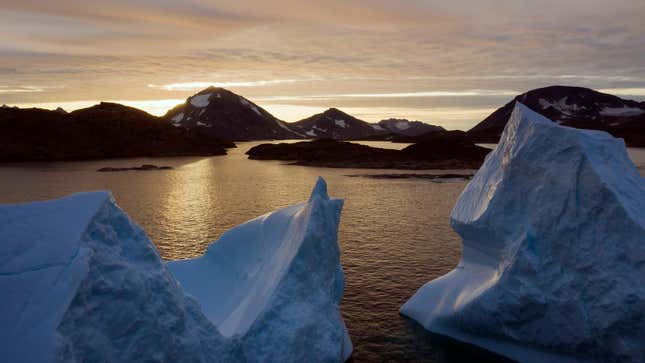
It’s been a minute since we’ve checked in on Greenland. Let’s see what’s... oh, oh no. The ice sheet covering the island went into a major meltdown last week, and it’s ongoing as we speak. Enough ice melted in one single day to cover Florida in 2 inches (5.1 centimeters) of water.
The single-day damage happened last Wednesday, according to data from the Danish government-funded Polar Portal. The rest of the week wasn’t so great for Greenland either: Tuesday saw the ice sheet lose 8.5 billion tons of surface mass, while Thursday logged 8.4 billion tons of ice. The rate of melt that happened last week is around twice the average pace of melt for the ice sheet during the summer.
A recent heat wave (relatively speaking, anyway) saw temperatures spike to 68 degrees Fahrenheit (20 degrees Celsius)—around twice the average summer temperature. Nerlerit Inaat airport, which is in the northeastern part of the island, last week logged a temperature of 74.1 degrees Fahrenheit (23.4 degrees Celsius), its highest-ever recorded temperature. Persistent high pressure has sat over Greenland, locking in largely sunny skies. All told, Polar Portal data shows that roughly two-thirds of the 656,000-square-mile (1.7-million-square-kilometer) ice sheet is experiencing some form of melt.
The melt could feed into a feedback loop that spells bad news for Greenland’s ice—and coasts that depend on it staying ice. As pure white ice and snow melt, it could expose darker ground or ice beneath, which absorbs more heat and could further melt the ice sheet.
“It’s a very high level of melting and it will probably change the face of Greenland, because it will be a very strong driver for an acceleration of future melting, and therefore sea level rise,” Marco Tedesco, a glacier expert at Columbia University and adjunct scientist at NASA, told the Guardian. “We had these sort of atmospheric events in the past but they are now getting longer and more frequent. The snow is like a protective blanket so once that’s gone you get locked into faster and faster melting, so who knows what will happen with the melting now. It’s amazing to see how vulnerable these huge, giant areas of ice are. I’m astonished at how powerful the forces acting on them are.”
In the summer of 2019, Greenland’s melt really got going, shedding 197 billion tons of ice in July alone. In a single day late that month, the ice sheet melted 12.5 billion tons of water. The melt was, no surprise, triggered by soaring temperatures that summer, which spiked between 18 to 36 degrees Fahrenheit (10 to 20 degrees Celsius) above normal. Overall that year, the island shed about 532 billion tons from its ice sheet, the largest loss in a single year since record-keeping began in 1948. For context, that’s enough to cover all of California in a jaw-dropping 4 feet (1.2 meters) of water. A study of the record melt led by Tedesco found that high pressure also contributed to the meltdown by keeping skies largely cloud-free.
While summer 2019 saw the most mass melt away, this week’s melt is occurring across a wider surface area. Either way, melt superlatives aren’t good news and are indicative of a bigger pattern on the island. Scientists have shown that melting this century is pushing the boundaries of historic ice loss. Greenland’s melt combined with ice loss in Antarctica has, since the late 1990s, already contributed to 0.7 inches (1.8 centimeters) of sea level rise. A mindboggling 7.1 trillion tons (6.4 trillion tonnes) of ice has turned to water over that period.
And all this melting is... not great for our long-term outlook. Greenland’s ice sheet contains enough water that, if it melted, would raise sea levels 23 feet (7 meters). Research published in 2019, during that summer’s massive melt event, forecast that all the ice in the sheet could melt by the year 3000 if we keep our emissions at the same level as today. That date may seem far in the future, but it’s a lot of ice at stake. Within our kids’ lifetimes, the same study predicts that Greenland’s melt could cause sea levels to rise between six inches and a foot (.15 to .3 meters) by 2100 if we don’t do anything, to say nothing of what happens in Antarctica and other ice on land. The outlook isn’t exactly great on those fronts either.